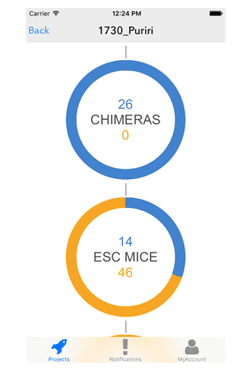Zinc fingers crossed
Zinc fingers crossed
In this issue
Feature
Latest publications
MyOzgene iPhone app
Frank’s blog
Timeline update
 Zinc fingers crossed
Zinc fingers crossed
Research into the physiological functions of proteins is an extensive field of modern biomedicine. Understanding the role that they play in the regulation of gene expression and interactions with external stimuli is a major focus. Zinc finger proteins are an important research area, as they can mediate interactions with DNA, RNA and other proteins.
Perry J. Blackshear, M.D., D.Phil. is head of the Post-Transcriptional Gene Expression Group at the National Institute of Environmental Health Sciences (NIEHS), part of the National Institutes of Health. His group studies CCCH-type TZF proteins, which is a small family of zinc finger proteins characterized by a tandem motif at the RNA binding region. Proteins of this family are expressed in all major groups of eukaryotes, from plants to humans, and are involved in species-specific control of mRNA turnover and protein translation. Tristetraprolin (TTP) is a prototype member of this family that has led to our current knowledge about these TZF proteins.
The dynamics of mRNA turnover influence gene expression in response to external stimuli. Dr. Blackshear’s group focuses on the molecular and biochemical regulation of gene expression by members of the CCCH TZF protein family, by assessing the effects of these proteins on mRNA stability and translation, and how this relates to physiology. The team have discovered the regulatory role of specific mammalian CCCH TZF proteins in gene expression that is implicated in processes such as the immune response to environmental cues and placental physiology. A major line of their research is in identifying the physiological mRNA target transcripts of these proteins.
Dr. Blackshear’s recent publication in PNAS, which utilises a mouse model generated by Ozgene, suggests that increasing endogenous levels of TTP might be advantageous in the treatment of inflammatory diseases. The team have previously discovered that one of the principal TTP targets is the mRNA encoding the pro-inflammatory cytokine tumour necrosis factor alpha (TNF), but other cytokines are also affected. This research led to the discovery that increased levels of TTP in the mouse decreased the severity of mouse models of inflammation, potentially sparking further research into environmental influences on the immune system and a possible lead for drug development.
This work and further research into other CCCH TZF family members and their interactive effects continues to improve our understanding of the mechanisms of gene expression and to shed light on the development of therapeutic treatments for disease.
For more information regarding Dr. Blackshear’s research, please see his recent PNAS publication below and visit the Post-Transcriptional Gene Expression Group website.
For more information on Ozgene mouse models, please see Ozgene services.
Latest publications
FEATURED – Proc Natl Acad Sci U S A. 2016 Feb 16.
Enhanced stability of tristetraprolin mRNA protects mice against immune-mediated inflammatory pathologies.
Patial S, Curtis AD 2nd, Lai WS, Stumpo DJ, Hill GD, Flake GP, Mannie MD, Blackshear PJ. – National Institute of Environmental Health Sciences; Integrated Laboratory Systems; East Carolina University Brody School of Medicine; Duke University Medical Center, NC, USA. [read]
J Interferon Cytokine Res. 2016 Apr.
The Role of Dectin-2 for Host Defense Against Disseminated Candidiasis.
Ifrim DC, Quintin J, Courjol F, Verschueren I, van Krieken JH, Koentgen F, Fradin C, Gow NA, Joosten LA, van der Meer JW, van de Veerdonk F, Netea MG. – Radboud University Nijmegen Medical Centre, The Netherlands; Inserm U995, France; Université de Lille, France; Ozgene Pty Ltd, Australia; Institute of Medical Sciences, University of Aberdeen, UK. [read]
Genesis. 2016 Mar 25.
Exclusive transmission of embryonic stem cell-derived genome through the mouse germline.
Koentgen F, Lin J, Katidou M, Chang I, Khan M, Watts J, Mombaerts P. – Ozgene Pty Ltd, Australia; Max Planck Research Unit for Neurogenetics, Germany. [read]
Am J Physiol Regul Integr Comp Physiol. 2016 Mar 23.
Cardiac hypertrophy and decreased high-density lipoprotein cholesterol in Lrig3-deficient mice.
Hellstrom M, Ericsson M, Johansson B, Faraz M, Anderson F, Henriksson R, Nilsson SK, Hedman H. – Umeå University, Sweden. [read]
 myOzgene iPhone app
myOzgene iPhone app
Would you like to follow the progress of your project real-time through your iPhone? We have been working on an app that will show your project milestones with a day-to-day timeline. You can also access further data on completed, failed and scheduled processes for each milestone.
Please let us know if you are interested in becoming a test user for the app, to give us valuable feedback before we roll it out to all of our clients. Stay tuned for further developments, including the Android version…
Frank’s blog: Jishu-what?
Our Lean philosophy is composed of two parts: people and process, the human system and the technical system. Both are encompassed by the daily process of continuous improvement that is the essence of Lean, described by the Japanese “Kaizen”. In the sense of continuity and human development Kaizen is the “never ending betterment of the self”. A Jishuken is a Kaizen activity or improvement workshop that brings together these two aspects of Lean…

 myOzgene iPhone app
myOzgene iPhone app



